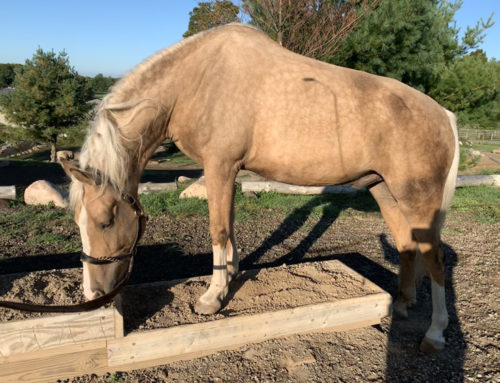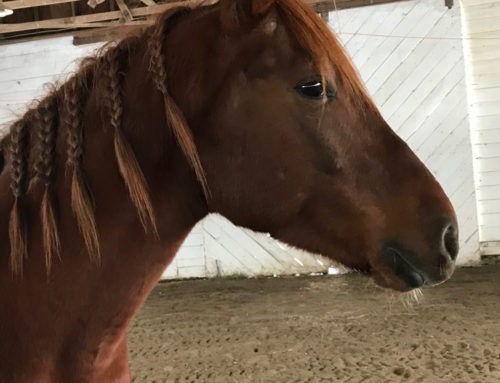By Natalie DeFee Mendick
Published in Equine Journal
 “The work you do in the arena is as important as the work you do on the trail, and vice versa. Horses need both; horses need balance.” –Cathy Drumm
“The work you do in the arena is as important as the work you do on the trail, and vice versa. Horses need both; horses need balance.” –Cathy Drumm
Who says all schooling has to take place in an arena? Time on the trail offers a change of scenery, a quieter pace, and a breath of fresh air…and also presents new training opportunities. Make supple and steady the name of your trail riding game!
Set the Stage
As you’re getting acclimated to the trail, whether it’s the end of winter, you have a new horse, or you’re new to the trail, start out thinking small. “Bite things off in little chunks,” recommends New England-based instructor Cathy Drumm, who teaches internationally across disciplines, including western dressage, dressage, and hunter/jumper. “Start with a short loop so the horse doesn’t get too anxious. Try not to push too far out of the horse’s comfort zone all at once- gradually build up.”
Once you’ve gotten rolling, think about the tempo you’d like in the arena, and hold your horse to that standard on the trail. Ask you horse to step rhythmically forward from the hindquarters to the bridle, even if you’re just walking on a longer rein. Dawdling is not an option. “Insist on a working walk just as much on the trail as in the arena,” says Drumm. “The horse should be marching forward with purpose, alert and listening to you, with a light contact between your hands and the horse’s mouth.”
Ask your horse to come on the bit for a few moments, staying forward, supple, and round. The trail is a good opportunity to keep your horse’s mind on you outside the confines of an arena, which will also later help in new surroundings, like at a horse show. Where footing allows, try a bit of posting trot, using your posting to help the horse stay in a clockwork rhythm.
For a horse that’s tense and quick, sit back, breathe deep, and stay soft in your hands. “If the horse jigs, half-halts are essential,” explains Drumm. “Stay very patient; impatience tends to make things worse.” Drumm notes horses tend to jig for two different reasons: “If the horse is jigging because he has too much energy, allow him to trot a bit, then walk, and repeat, using transitions to maintain balance,” she suggests. “If he’s jigging because he’s afraid, sometimes it makes sense to get off the horse and lead him, especially if his jigging is making you afraid. I always tell people it’s not a sin to get off your horse.”
By riding with appropriate contact, Drumm explains you are able to stay effective. “If the horse suddenly spooks or hits rough ground, you can make adjustments if needed,” she says, noting half-halts play a role as well, “You don’t want the horse to be leaning on you on the trail any more than you would want him to be leaning on you in the arena. You always have to practice rebalancing half-halts, whether on the trail or in the arena, in order to make a change. On the trail this could be, for example, where the footing shifts or before crossing water. This helps the horse to engage and pay attention.”
Step Up the Game
Outdoor riding on slopes offers conditioning opportunities beyond the arena. “There’s nothing better to develop your horse’s rear end and back muscles than going up and down hill,” remarks Drumm. In a light seat, incorporate gentle inclines into your ride, asking your horse to stretch downward over the topline while walking and trotting uphill.
Walking downhill keep your horse straight and balanced. “When you go uphill and maintain the same tempo and rhythm, you will find that your horse reaches his head and neck forward and really has to push from the rear end to get up the hill. This develops everything you need for a good free walk,” remarks Drumm. “Going downhill, ask the horse to engage his rear end and lift his front end a bit.” Stick to milder grades so as to not overtax your horse.
Choose a point in the distance and ride toward it, practicing riding straight. Still on that line, ride into a square halt, quietly asking your horse to remain immobile yet attentive. Ride upward and downward transitions, maintaining balance. “Transitions help the horse stay awake on the trail,” says Drumm. “They tend to startle when they are half asleep.” If room allows on the trail, practice changing bend through a slight serpentine taking the width of the trail. “When you turn or ride on a bent line on the trail, ask for the same bending as you would in the arena,” Drumm recommends.
Later in your ride you can then add in steps of shoulder-fore, haunches-in, and leg yield or half-pass if your horse is already learning lateral movements. “The best place to work on your lateral work is when you turn towards home, especially on a dirt road or wide track where you can freely go side to side. The horse will happily have impulsion heading towards home, so you can work on sideways without having to create the impulsion that you would have to in the arena,” notes Drumm.
Get Out & Get Going!
Mix up your routine- a little bridle-path schooling provides a new perspective for you and your horse. Take advantage of whatever the trail brings your way- an improved attitude, more forward energy, less anticipation- for an easy-going tune-up.
Be considerate of the other riders if you are out in a group, allowing the slowest rider to set the pace. Also remember to share the trail with other trail users (think hikers, bikers, and any other outdoor enthusiasts) you may come across- be a good ambassador for the equine community.
For some horses, riding in the open can prove awfully exciting. Know your horse- if you think you may have a fresh horse outdoors, work him before going out. Ride with a buddy if need be. Be smart and safe.
Interview and article written by Natalie DeFee Mendik who is an award-winning journalist specializing in equine media. Her personal horse passions include dressage and vaulting. Visit her online at www.MendikMedia.com.






